Abstract
Solid-state batteries (SSBs) are gaining attention as they promise to provide better safety and a higher energy density than conventional liquid electrolyte batteries. Solid polymer electrolytes (SPEs) are promising candidates due to their flexibility providing better interfacial contact between electrodes and the electrolyte. However, SPEs exhibit very low ionic conductivity at ambient temperatures, which prevents their practical use in batteries. Herein, a simple and effective technique of hot press rolling is demonstrated to improve ionic conductivity and, hence, the performance of polyvinylidene fluoride-co-hexafluoropropylene (PVDF-HFP)-based solid polymer electrolyte. Applying hot press rolling to the electrolyte membrane induced structural changes in the grain boundaries, which resulted in a reduction in the crystallinity of the material and, hence, an increase in the amorphous phase of the material, which eased the movement of the lithium ions within the material. This technique also improved the surface of the membrane, making it homogeneous and smoother, which resulted in better interfacial contact between the electrodes and electrolyte. Electrochemical tests were carried out on electrolyte membranes treated with and without hot press rolling to evaluate the effect of the treatment. The hot pressed electrolyte membrane showed significant improvements in its ionic conductivity and transference number. The cycling performance of the LFP/Li batteries using a hot press rolled electrolyte was also evaluated, which gave a specific discharge capacity of 134 mAh/g at 0.1 C. These results demonstrate that hot press rolling can have a significant effect on the electrochemical performance of solid polymer electrolytes.
1. Introduction
Climate change and global warming are real issues that demand immediate attention. The transportation sector, which operates on fossil fuels, contributes 16.2 percent of carbon emissions [1]. Replacing fossil fuels with electricity in transport vehicles is a promising way to reduce carbon emissions. The current battery systems cannot fulfill the demands of electric vehicles in terms of energy density, power density, and safety. In addition, conventional batteries contain an organic liquid electrolyte which is flammable and causes serious safety issues. Solid-state batteries (SSBs) are a promising solution as they result in fewer safety concerns compared to conventional batteries with liquid electrolytes as solid electrolytes are thermally more stable [2]. The use of solid electrolytes also paves the way for the use of lithium metal as the anode, which is not possible with liquid electrolytes because of their high reactivity with lithium metal [3]. Lithium metal is a favorable anode material owing to its high energy density (3680 mAh/g), which is 10 times better than the specific capacity provided by conventional graphite anodes [3,4]. Irrespective of all these advantages, several challenges such as the low ionic conductivity of solid electrolytes, high interfacial resistance and instability between electrodes and solid electrolytes remain to be addressed before the use of SSBs becomes practical [5,6].
Generally, solid electrolytes can be classified into three categories: inorganic solid electrolytes (ISEs), solid polymer electrolytes (SPEs), and composite solid polymer electrolytes (CSPEs) [7]. Each solid electrolyte has its own advantages and challenges to overcome. Inorganic solid electrolytes (sulfides, oxides, phosphates) usually have high ionic conductivity but face the challenge of high solid–solid interfacial resistance between the electrodes and electrolyte [8]. The application of pressure at the cellular level is required for batteries using ceramic solid electrolytes. Solid polymer electrolytes (SPEs) consist of a polymer matrix and lithium salts, and possess excellent flexibility, good solid–solid interfacial contact, and easy processability [8,9], but present low ionic conductivity (< S/cm) in ambient conditions, as well as having inferior thermal and electrochemical stability [7]. Composite solid polymer electrolytes (CSPEs) are made by adding inorganic ceramic as filler into solid polymer electrolytes [10], and they promise to inherit the advantages of both SPEs and inorganic fillers, such as better ionic conductivity, flexibility, and mechanical strength.
In solid polymer electrolytes (SPEs), PEO is the most extensively studied polymer matrix, mainly due to its ability to dissolve alkali-metal salts, low glass transition temperature, and non-toxicity [11]. On the other hand, PVDF-HFP is a good candidate for a polymer matrix due to its low crystallinity, high dielectric constant (ε = 8.4), which helps to dissolve lithium salts to a greater extent, and good mechanical stability over a wide range of temperatures [12,13,14,15]. However, ionic conductivity is the most important indicator when evaluating the performance of an electrolyte, which is determined by the mobility of the charge carriers. The ionic conductivity of solid polymer electrolytes is severely affected by the large crystalline domains present in the polymer chains [16]. Crystallinity is a fundamental characteristic of polymeric systems which defines mechanical, thermal, optical, electronic, and transport properties [17,18,19]. A high crystallinity limits the movement of lithium ions [20,21] and, hence, enhances the ionic conductivity of SPEs. Several approaches, such as adding plasticizer and incorporating ceramic filler, have been widely explored [22,23,24,25,26] and demonstrated to successfully disrupt this crystallinity. However, a simple processing technique can also greatly influence the quality of the electrolyte. For example, Wang et al. [27] used an ultrasonic vibrational technique to suppress the crystallinity of solid polymer electrolytes, which resulted in improvements in the ionic conductivity of the electrolytes.
In this work, a solid polymer electrolyte made of a Polyvinylidene fluoride-co-hexafluoropropylene (PVDF-HFP) polymer matrix and a Bis(trifluoromethylsulfonyl)amine (LiTFSI) lithium salt was studied. A simple and effective technique of hot press rolling was implemented to reduce the crystalline matrix present in the polymer chains and to improve the performance of the SPE. In solid polymer electrolytes, lithium ions are thought to be transported through grain boundaries and an amorphous phase [28]. The use of hot press rolling with maintained pressure and temperature on the solid electrolyte membrane can break grains and reform grain boundaries, which increases the amorphous region; hence, it has the potential to be applied to SPEs to reduce the crystallinity of the polymers and improve the ionic conductivity of the electrolytes. Furthermore, detailed electrochemical analyses of the hot press rolled and non-hot press rolled SPEs were carried out to evaluate their performances in lithium-metal battery application.
2. Materials and Methods
2.1. Materials Used
Polyvinylidene fluoride-co-hexafluoropropylene (PVDF-HFP) (average relative molecular mass of ~455,000), Bis(trifluoromethylsulfonyl)amine (LiTFSI) lithium salt (99.95%), Lithium iron phosphate (LiFePO4), and N-Methyl-2-pyrrolidone (NMP) (99.95%) were purchased from Sigma-Aldrich and used as received. Carbon (Super-p) was purchased from Alfa Aesar. The chemical structures of the polymer and lithium salt used in the preparation of the solid polymer electrolytes is shown in Figure 1.
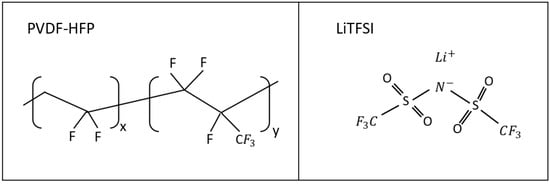
Figure 1.
Chemical structures of polymer Polyvinylidene fluoride-co-hexafluoropropylene (PVDF-HFP) and lithium salt Bis(trifluoromethylsulfonyl)amine (LiTFSI) used for the preparation of the solid polymer electrolytes.
2.2. Methods
2.2.1. Preparation of Solid Polymer Electrolyte Membranes
The solid polymer electrolyte membranes were prepared by a solution casting technique. The polymer matrix (PVDF-HFP) to lithium salt (LiTFSI) ratio was kept constant at 2:1 wt%. LiTFSI (1.25 g) was dissolved in NMP (10 mL) and stirred on a heating plate at 50 °C for 2 h (Figure 2a,b). Thereafter, PVDF-HFP (2.5 g) was added and stirring continued for 12 h (Figure 2c). The resultant slurry was poured into a petri dish, and the solvent was allowed to evaporate slowly at room temperature in a dry room (dew point: −50 °C ) for 12 h (Figure 2d,e). Residual solvents were further removed by drying in a vacuum oven at 80 °C for 16 h (Figure 2f). As a result, the solid polymer electrolyte (SPE) self-standing films were obtained (Figure 2g). Similarly, the desired amount of SPE was fabricated and hot press rolling treatment was performed under controlled conditions. From here onwards, the membranes without hot press rolling treatment are named SPE and those with hot press rolling treatment are named R-SPE. The final thicknesses of both types of electrolyte membrane were kept the same, within the range of 85–100 μm. Membranes were then cut into circular disks with diameters of 18 mm and were stored in a glovebox for further testing. The final images of a membrane are shown in Figure 3.
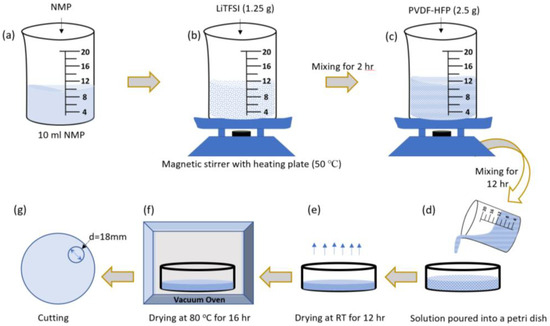
Figure 2.
(a–g) Preparation method for PVDF-HFP/LiTFSI-based solid polymer electrolytes (SPEs).
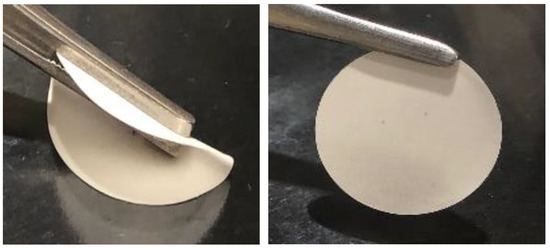
Figure 3.
PVDF-HFP/LiTFSI-based solid polymer electrolyte (SPE).
2.2.2. Hot Press Rolling Treatment of Solid Polymer Electrolytes
The equipment (Figure 4) used to perform the hot press rolling treatment of the as-prepared solid polymer electrolyte membranes was a Hot Rolling Press (MSK-HRP-MR100DC, MTI). The membranes were treated under controlled conditions (Temperature = 60 °C, rolling speed = 4 rpm (speed display units in instrument), rolling gap = 0.1 mm). This treatment of the membranes is thought to deform the grain boundaries of the polymer structure, as shown in Figure 5, and more grain boundaries are created.
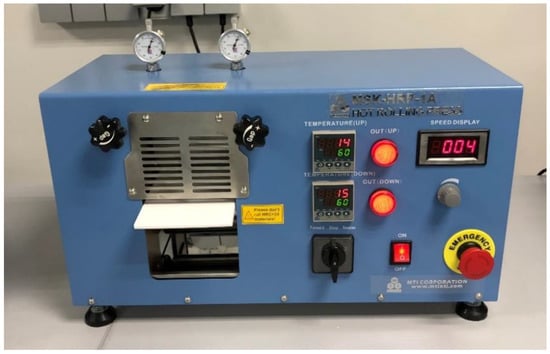
Figure 4.
Equipment used for the hot press rolling of solid polymer electrolytes.

Figure 5.
Grain boundary deformation in a solid polymer electrolyte after hot press rolling.
2.2.3. Catholyte Preparation
Catholyte was prepared through a conventional doctor-blade method. A homogeneous slurry was prepared with the lithium iron phosphate (LFP), carbon (Super-P), and solid polymer electrolyte (SPE) solution in a mass ratio of 80:10:10. A homogeneous slurry was prepared and then coated on aluminum foil with the help of the doctor blade, with a wet slurry thickness of 200 µm. The electrode sheets were dried at room temperature for 2 days and then cut into 15 mm diameter disks. All preparations and electrode cutting were performed in a dry room with an approximately −50 °C dew point. The disks were finally dried at 100 °C in vacuum for 16 h. The active material (LFP) mass loading of the as-prepared electrodes was ~3.5 mg/cm2.
2.3. Characterization Methods
2.3.1. Electrochemical Impedance Spectroscopy (EIS)
Electrochemical impedance spectroscopy (EIS) measurements were implemented on a VSP Biologic in a frequency range of 10 kHz–10 Hz to measure the ionic conductivity of the hot press rolled and non-hot press rolled solid polymer electrolytes.
2.3.2. Direct Current (DC) Polarization
The lithium ion transference numbers of the SPE and Cal-SPE were measured by performing AC impedance and DC polarization of a Li/SPE/Li symmetrical cell in a coin cell (CR2032) setup. EIS measurements were performed before and after the DC polarization test. The voltage applied for DC polarization was 10 mV.
2.3.3. Linear Sweep Voltammetry (LSV)
The electrochemical window was determined by linear sweep voltammetry (LSV) using a Li/SPE/SS configuration in a coin cell (CR2032). The tests were carried out at a scan rate of 0.1 mV/s over a potential range of 0–5.5 V.
2.3.4. Symmetrical Cell Cycling
To see the stability of the electrolyte membranes against Li dendrite propagation, galvano-static cycling tests were carried out on symmetric cells (Li/SPE/Li), in a coin cell (CR2032), at constant current densities of 0.1 mA/cm2, 0.2 mA/cm2, and 0.5 mA/cm2 at 60 °C.
2.3.5. Galvano-Static Charge–Discharge Cycling
The electrochemical performance of the solid polymer electrolytes was tested with LFP/Li half cells with as-prepared LFP catholyte and Li metal as the anode. Coin cells (CR2032) were assembled in an argon-filled glovebox (BRAUN, Germany, H2O and O2 ≤ 1 ppm). Charge and discharge tests were carried out over a 2.8–3.8 V voltage range at 60 °C. Two formation cycles at C/50 were carried out before testing at high C-rates.
3. Results and Discussion
3.1. Ionic Conductivity
To find the ionic conductivity of the solid polymer electrolytes SPE and R-SPE, cells with the configuration Li/electrolyte/Li in a coin cell setup were fabricated, and EIS tests were conducted at different temperatures of 10 °C, 20 °C, 30 °C, 40 °C, 50 °C, and 60 °C (Figure 6).
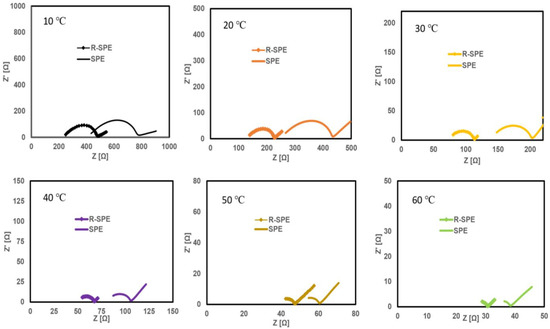
Figure 6.
Nyquist plots for SPE and R-SPE electrolytes at different temperatures.
The bulk resistance values were obtained by fitting the equivalent circuit (Figure 7) using Z-fit in EC-Lab software. The fitting of the experimental data to this circuit model allows the estimation of bulk resistances (R2). The results of this fitting demonstrate that the R-SPE electrolyte showed lower bulk resistance values compared to the SPE electrolyte. The ionic conductivities (σ) were calculated from Equation (1):
where A (cm2) is the area, L (cm) is the thickness of the SPE membrane, and R (Ω) is the bulk resistance.

Figure 7.
Equivalent circuit proposed to model the ionic conductivity of the solid polymer electrolytes.
Impedance and ionic conductivity values at different temperatures for both electrolytes are summarized in Table 1. The ionic conductivities of the SPE at 10 °C and 60 °C were S/cm and S/cm, respectively, whereas the ionic conductivities of R-SPE at 10 °C and 60 °C were and , respectively. These ionic conductivity values are in good agreement with the literature, which discusses solid polymer electrolytes based on the same materials [29,30]. These results clearly indicate that the ionic conductivity of the R-SPE electrolyte s better than that of the SPE. This improvement in the ionic conductivity of the electrolyte can be attributed to the decrease in the crystallinity of the polymer by the application of hot press rolling. This reduction in the crystallinity enhanced the amorphous region in the material, which improved the mobility of lithium ions.

Table 1.
Impedance and ionic conductivity values for SPE and R-SPE at different temperatures.
The temperature dependence of the ionic conductivity of both electrolytes, SPE and R-SPE, is shown by Arrhenius curves (Figure 8). The plot illustrates a linear behavior and follows the Arrhenius relationship. The results demonstrate that both electrolytes showed similar temperature-dependent ionic conductivity behavior, showing increases in ionic conductivity with the temperature increase. The increases in ionic conductivity with temperature can be attributed to increases in free volume, polymer segmental mobility, and ionic mobility [31].
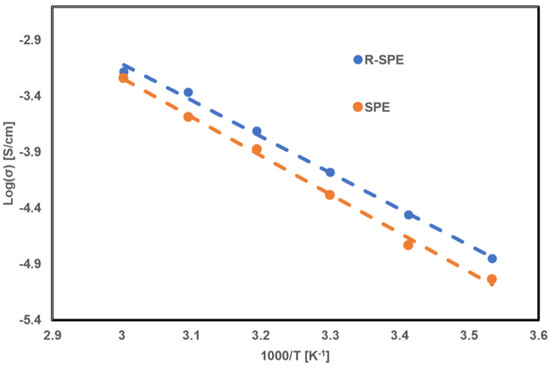
Figure 8.
Log σ versus 1000/T plot for SPE and R-SPE electrolytes.
The activation energies were calculated by the Arrhenius equation:
where σ, , T, , R are the ionic conductivity, pre-exponential factor, temperature, activation energy, and gas constant, respectively.
The activation energies were calculated as 0.29 eV and 0.31 eV for the R-SPE and SPE, respectively, being in good agreement with the previously reported values for solid polymer electrolytes [32]. The low activation energy of the R-SPE is attributed to an increase in the amorphous region by hot press rolling, which eased lithium-ion movement within the electrolytes. The lower activation energy indicates that lithium ions needed less energy to move within the electrolytes [33].
3.2. Direct Current (DC) Polarization and Transference Number
The Li-ion transportation number () is an important parameter when considering the transportation of lithium ions in solid polymer electrolytes. Coin cells with the configurations Li/SPE/Li and Li/R-SPE/Li were prepared, and DC polarization was performed until a steady-state current was reached (Figure 9c). EIS tests were also conducted before and after the DC polarization for Li/R-SPE/Li and Li/SPE/Li cells (Figure 9a and Figure 9b, respectively). Transference numbers () were calculated by using the Bruce–Vincent–Evans equation [34]:
where ∆V is the applied polarization voltage; and are the initial current and initial interfacial resistance values before polarization, respectively; and and are the steady-state current and interfacial resistance values after polarization, respectively. The and values for both the electrolytes were calculated from impedance results before and after DC polarization (Figure 9a,b).
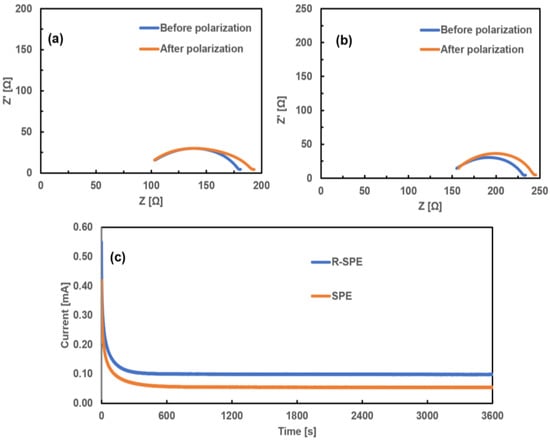
Figure 9.
EIS of (a) Li/R-SPE/Li and (b) Li/SPE/Li cells before and after polarization, and (c) DC polarization curve.
At room temperature, the transference numbers for the SPE and R-SPE were calculated as 0.12 and 0.18, respectively, which are close to the literature values [21]. The for the R-SPE was higher than the transference number of the SPE. The remarkable improvement in the lithium-ion transference number can be ascribed to an increase in the grain boundaries. By applying the hot press rolling, the grain boundaries were reformed, which created more pathways for lithium ions to move along. These results are in good agreement with the ionic conductivity results as the movement of lithium ions played an important role in the conductivity improvement.
3.3. Linear Sweep Voltammetry (LSV)
Linear sweep voltammetry (LSV) at 60 °C for both the SPE and R-SPE was performed to evaluate their voltage stability windows (Figure 10). Both electrolytes showed stability up to 4.1 V. Slight differences in the results could be due to differences in the OCV values of the cells; otherwise, no significant effect of hot press rolling on the stability voltages was observed.
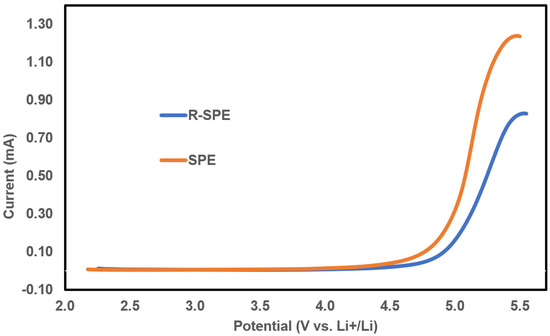
Figure 10.
Linear sweep voltammetry (LSV) tests for SS/SPE/Li and SS/R-SPE/Li cells to evaluate their voltage stability windows.
3.4. Symmetrical Cell Cycling
To further investigate the electrochemical stability of electrolytes with a Li-metal anode, symmetric cells with configurations Li/SPE/Li and Li/R-SPE/Li were fabricated and subsequently implemented for plating/striping tests to measure the stability of the electrolytes against lithium dendrite. A current density of 0.1 mA/cm2 was applied for the first 500 cycles, followed by 0.2 mA/cm2 for the next 500 cycles, then continuing at 0.5 mA/cm2 until the cell began to short circuit. This test was performed at 60 °C. Hot press rolled membranes (R-SPE) showed better stability against lithium dendrite growth compared to non-hot press rolled membranes (SPE). In addition, the Li/R-SPE/Li cell performed more cycles (nearly 100 more) compared to the Li/SPE/Li cell (Figure 11).
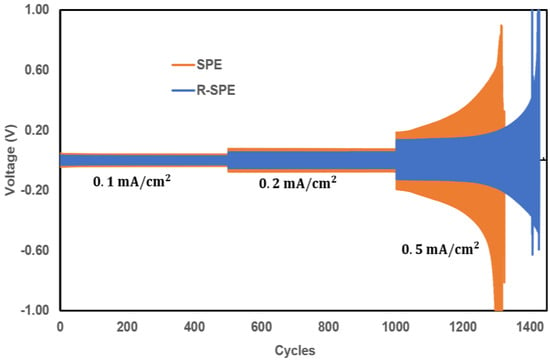
Figure 11.
Cycling of symmetrical cells with configurations of Li/SPE/Li and Li/R-SPE/Li.
3.5. Galvano-Static Charge–Discharge Cycling
The cycling profiles of the LFP/SPE/Li and LFP/R-SPE/Li cells were tested under a current density of 0.1 C at 60 °C. For the LFP/R-SPE/Li cell, a first discharge specific capacity of 134.3 mAh/g was achieved, whereas for the LFP/SPE/Li cell it was 118 mAh/g (Figure 12a). The LFP/R-SPE/Li cell retained more than 98.5% coulombic efficiency over the first 50 cycles (Figure 12c). The improved cycling performance of the LFP/R-SPE/Li cell can be attributed to the improved ionic conductivity of the electrolyte and interfacial contact between the electrodes and electrolyte after the application of the hot press rolling treatment.
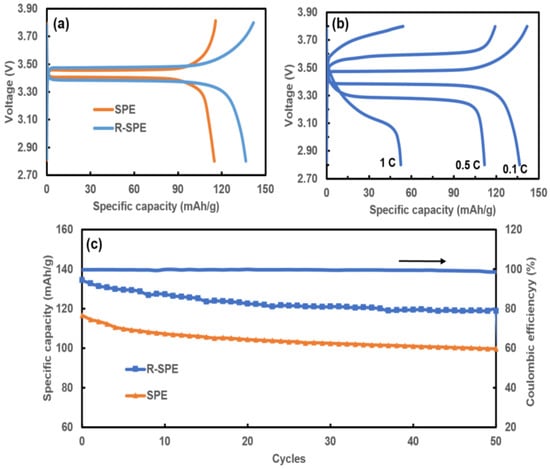
Figure 12.
Cycling results for LFP/Li batteries. (a) First discharge cycles with SPE and R-SPE electrolytes at 0.1 C and 60 °C, and (b) with R-SPE electrolytes at 0.1 C, 0.5 C, and 1 C. (c) Long cycle performance with SPE and R-SPE, and coulombic efficiency for a battery with R-SPE.
Figure 12b shows the cycling results of the LFP/R-SPE/Li cell at different C-rates of 0.1 C, 0.5 C, and 1 C. At high C-rates, a decline in the capacity of the cell can be seen. This is due to the fast degradation of the battery at high C-rates [35].
The results evidence that the hot press rolling treatment improved the electrochemical performance of the solid polymer electrolyte.
4. Conclusions
The ionic conductivity of an electrolyte is greatly affected by the degree of crystallinity of the polymer matrix. In this work, a simple and effective technique of hot press rolling has been shown to improve the performance of solid polymer electrolytes. Rolling at high temperature and pressure causes grain boundary changes in the polymer structure, resulting in an increase in the amorphous region. An unstructured amorphous region helps the movement of lithium ions within the electrolyte.
A significant improvement in the ionic conductivity of the electrolyte was achieved by the application of the hot press rolling technique. It has been experimentally shown that, at 10 °C, the ionic conductivity of the electrolyte increased from S/cm to S/cm, a 53% increase.
The activation energies for both electrolytes were calculated by plotting an Arrhenius curve. For SPEs, it was 0.31 eV and, after hot press rolling treatment, it decreased to 0.29 eV. A lower activation energy means easier Li-ion movement within the electrolyte. Large grain boundaries are unfavorable for Li-ion transport. By applying hot press rolling, the grain boundaries are deformed, which creates more pathways for lithium ions to move along.
An overall improvement in the electrochemical performance of the solid polymer electrolyte has been shown. The smooth surface of the electrolyte provided better contact between the electrode and electrolyte, which improved the performance of the cell. The LFP/R-SPE/Li batteries showed a first discharge capacity of 134.3 mAh/g at 0.1 C, which is better than the capacity shown by LFP/SPE/Li batteries (118 mAh/g). The homogenous structure of the membranes has obvious advantages in improving the performance of the electrolyte.
All the results show that hot press rolling is an effective technique that is easy to implement and improves the performance of solid polymer electrolytes for solid-state lithium-metal batteries.
Author Contributions
M.B. and P.Y. initiated the research. M.B. and J.V.M. supervised the work. P.Y. prepared the samples. P.Y. and S.H.B. performed experiments. P.Y. wrote the paper with contributions from A.R.K. and P.I. All authors have read and agreed to the published version of the manuscript.
Funding
This research was funded by the project “Bridge–Green Chemistry” which received research grant from INNOVIRIS.
Institutional Review Board Statement
Not applicable.
Informed Consent Statement
Not applicable.
Conflicts of Interest
The authors declare no conflict of interest.
References
- Hannah Ritchie and Max Roser (2020)—“CO₂ and Greenhouse Gas Emissions”. Available online: https://ourworldindata.org/ (accessed on 25 November 2021).
- Wan, J.; Xie, J.; Mackanic, D.; Burke, W.; Bao, Z.; Cui, Y. Status, promises, and challenges of nanocomposite solid-state electrolytes for safe and high performance lithium batteries. Mater. Today Nano 2018, 4, 1–16. [Google Scholar] [CrossRef]
- Kim, H.; Jeong, G.; Kim, Y.-U.; Kim, J.-H.; Park, C.-M.; Sohn, H.-J. Metallic anodes for next generation secondary batteries. Chem. Soc. Rev. 2013, 42, 9011–9034. [Google Scholar] [CrossRef] [PubMed]
- Wang, Q.; Yao, Z.; Zhao, C.; Verhallen, T.; Tabor, D.P.; Liu, M.; Ooms, F.; Kang, F.; Aspuru-Guzik, A.; Hu, Y.-S.; et al. Interface chemistry of an amide electrolyte for highly reversible lithium metal batteries. Nat. Commun. 2020, 11, 4188. [Google Scholar] [CrossRef]
- Albertus, P.; Anandan, V.; Ban, C.; Balsara, N.; Belharouak, I.; Buettner-Garrett, J.; Chen, Z.; Daniel, C.; Doeff, M.; Dudney, N.J.; et al. Challenges for and Pathways toward Li-Metal-Based All-Solid-State Batteries. ACS Energy Lett. 2021, 6, 1399–1404. [Google Scholar] [CrossRef]
- Lv, F.; Wang, Z.; Shi, L.; Zhu, J.; Edström, K.; Mindemark, J.; Yuan, S. Challenges and development of composite solid-state electrolytes for high-performance lithium ion batteries. J. Power Sources 2019, 441, 227175. [Google Scholar] [CrossRef]
- Li, S.; Zhang, S.; Shen, L.; Liu, Q.; Ma, J.; Lv, W.; He, Y.; Yang, Q. Progress and Perspective of Ceramic/Polymer Composite Solid Electrolytes for Lithium Batteries. Adv. Sci. 2020, 7, 1903088. [Google Scholar] [CrossRef] [Green Version]
- Fergus, J.W. Ceramic and polymeric solid electrolytes for lithium-ion batteries. J. Power Sources 2010, 195, 4554–4569. [Google Scholar] [CrossRef]
- Yue, L.; Ma, J.; Zhang, J.; Zhao, J.; Dong, S.; Liu, Z.; Cui, G.; Chen, L. All solid-state polymer electrolytes for high-performance lithium ion batteries. Energy Storage Mater. 2016, 5, 139–164. [Google Scholar] [CrossRef]
- Yu, Q.; Jiang, K.; Yu, C.; Chen, X.; Zhang, C.; Yao, Y.; Jiang, B.; Long, H. Recent progress of composite solid polymer electrolytes for all-solid-state lithium metal batteries. Chin. Chem. Lett. 2021, 32, 2659–2678. [Google Scholar] [CrossRef]
- Jiang, Y.; Yan, X.; Ma, Z.; Mei, P.; Xiao, W.; You, Q.; Zhang, Y. Development of the PEO Based Solid Polymer Electrolytes for All-Solid State Lithium Ion Batteries. Polymers 2018, 10, 1237. [Google Scholar] [CrossRef] [Green Version]
- Zhou, X.; Zhao, X.; Suo, Z.; Zou, C.; Runt, J.; Liu, S. Electrical breakdown and ultrahigh electrical energy density in poly(vinylidene fuoride-hexafuoropropylene) copolymer. Appl. Phys. Lett. 2009, 94, 162901. [Google Scholar] [CrossRef] [Green Version]
- Han, W.; Kim, T.; Yoo, B.; Park, H.-H. Tunable Dielectric Properties of Poly(vinylidenefluoride-co-hexafluoropropylene) Films with Embedded Fluorinated Barium Strontium Titanate Nanoparticles. Sci. Rep. 2018, 8, 4086. [Google Scholar] [CrossRef] [Green Version]
- Mindemark, J.; Lacey, M.J.; Bowden, T.M.; Brandell, D. Beyond PEO—Alternative host materials for Li + -conducting solid polymer electrolytes. Prog. Polym. Sci. 2018, 81, 114–143. [Google Scholar] [CrossRef]
- Fasciani, C.; Panero, S.; Hassoun, J.; Scrosati, B. Novel configuration of poly(vinylidenedifluoride)-based gel polymer electrolyte for application in lithium-ion batteries. J. Power Sources 2015, 294, 180–186. [Google Scholar] [CrossRef]
- Golodnitsky, D.; Strauss, E.; Peled, E.; Greenbaum, S. Review—On Order and Disorder in Polymer Electrolytes. J. Electrochem. Soc. 2015, 162, A2551–A2566. [Google Scholar] [CrossRef]
- Robbins, A.B.; Minnich, A.J. Crystalline polymers with exceptionally low thermal conductivity studied using molecular dynamics. Appl. Phys. Lett. 2015, 107, 201908. [Google Scholar] [CrossRef] [Green Version]
- Mileva, D.; Tranchida, D.; Gahleitner, M. Designing polymer crystallinity: An industrial perspective. Polym. Cryst. 2018, 1, e10009. [Google Scholar] [CrossRef]
- Tashiro, K. Handbook of Polymer Crystallization; John Wiley & Sons, Ltd.: Hoboken, NJ, USA, 2013; pp. 165–196. [Google Scholar] [CrossRef]
- Chang, C.-W.; Lai, W.-C. A strategy for preparing solid polymer electrolytes via the electrospinning process. J. Taiwan Inst. Chem. Eng. 2020, 116, 279–285. [Google Scholar] [CrossRef]
- St-Onge, V.; Cui, M.; Rochon, S.; Daigle, J.-C.; Claverie, J.P. Reducing crystallinity in solid polymer electrolytes for lithium-metal batteries via statistical copolymerization. Commun. Mater. 2021, 2, 83. [Google Scholar] [CrossRef]
- Tarascon, J.-M.; Armand, M. Issues and challenges facing rechargeable lithium batteries. Nature 2001, 414, 359–367. [Google Scholar] [CrossRef]
- Croce, F.; Sacchetti, S.; Scrosati, B. Advanced, lithium batteries based on high-performance composite polymer electrolytes. J. Power Sources 2006, 162, 685–689. [Google Scholar] [CrossRef]
- Lee, H.S.; Yang, X.Q.; McBreen, J.; Xu, Z.S.; Skotheim, T.A.; Okamoto, Y. Ionic Conductivity of a Polymer Electrolyte with Modified Carbonate as a Plasticizer for poly(ethylene oxide). J. Electrochem. Soc. 1994, 141, 886–889. [Google Scholar] [CrossRef]
- Zhan, H.; Wu, M. Excellent Performances of Composite Polymer Electrolytes with Porous Vinyl-Functionalized SiO2 Nanoparticles for Lithium Metal Batteries. Polymers 2021, 13, 2468. [Google Scholar] [CrossRef]
- Xu, L.; Li, G.; Guan, J.; Wang, L.; Chen, J.; Zheng, J. Garnet-doped composite polymer electrolyte with high ionic conductivity for dendrite-free lithium batteries. J. Energy Storage 2019, 24, 100767. [Google Scholar] [CrossRef]
- Wang, H.; Cui, X.; Zhang, C.; Gao, H.; Du, W.; Chen, Y. Promotion of Ionic Conductivity of PEO-Based Solid Electrolyte Using Ultrasonic Vibration. Polymers 2020, 12, 1889. [Google Scholar] [CrossRef] [PubMed]
- Wei, Z.; Ren, Y.; Wang, M.; He, J.; Huo, W.; Tang, H. Improving the Conductivity of Solid Polymer Electrolyte by Grain Reforming. Nanoscale Res. Lett. 2020, 15, 122. [Google Scholar] [CrossRef] [PubMed]
- Mathies, L.; Diddens, D. Transport mechanism of lithium ions in non-coordinating P(VdF-HFP) copolymer matrix. Solid State Ion. 2020, 357, 115497. [Google Scholar] [CrossRef]
- Wang, F.; Li, L. Influence of additives in PVDF-base solid polymer electrolyte. Sustain. Energy Fuels 2018, 2, 492–498. [Google Scholar] [CrossRef]
- Ataollahi, N.; Ahmad, A.; Hamzah, H.; Rahman, M.; Sabirin, M.N. Ionic Conductivity of PVDF-HFP/MG49 Based Solid Polymer Electrolyte. Adv. Mater. Res. 2012, 501, 29–33. [Google Scholar] [CrossRef]
- Gonçalves, R.; Miranda, D.; Almeida, A.M.L.D.F.; Silva, M.; Meseguer-Dueñas, J.M.; Ribelles, J.G.; Lanceros-Méndez, S.; Costa, C. Solid polymer electrolytes based on lithium bis(trifluoromethanesulfonyl)imide/poly(vinylidene fluoride -co-hexafluoropropylene) for safer rechargeable lithium-ion batteries. Sustain. Mater. Technol. 2019, 21, e00104. [Google Scholar] [CrossRef] [Green Version]
- Leš, K.; Jordan, C.-S. Ionic conductivity enhancement in solid polymer electrolytes by electrochemical in situ formation of an interpenetrating network. RSC Adv. 2020, 10, 41296–41304. [Google Scholar] [CrossRef]
- Colin, J.E.; Vincent, A. Electrochemical measurement of transference numbers in polymer electrolytes. Polymer 1987, 28, 2324–2328. [Google Scholar]
- Eftekhari, A. Lithium-Ion Batteries with High Rate Capabilities. ACS Sustain. Chem. Eng. 2017, 5, 2799–2816. [Google Scholar]
Publisher’s Note: MDPI stays neutral with regard to jurisdictional claims in published maps and institutional affiliations. |
© 2022 by the authors. Licensee MDPI, Basel, Switzerland. This article is an open access article distributed under the terms and conditions of the Creative Commons Attribution (CC BY) license (https://creativecommons.org/licenses/by/4.0/).